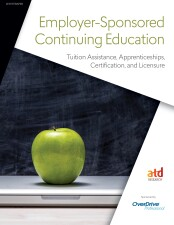ATD Blog
Using the MBTI Approach for Team Development in the Hybrid Workplace
Mon Aug 15 2022

Bookmark
Many people find the Myers-Briggs Type Indicator (MBTI) assessment particularly useful for team development. This may be, at least in part, because the MBTI approach not only helps people understand themselves but also provides a framework for understanding how their teammates are different—and shows the positive aspects of those differences as well as possible pitfalls.
Different exercises have been developed using the MBTI approach in team building, but most come from a world where people work in the same physical location as their co-workers.
Now, especially since the COVID-19 pandemic, many people work in a hybrid or virtual way, working from home most or all the time. Some teams may incorporate members living in different countries who will rarely, if ever, physically meet.
Can the MBTI approach still be used for teams like these? In our consultancy work, we have shown that it can, though the way in which it is used will be a little different from its application in a co-located team.
The Challenges of Working in a Hybrid Team
First, it’s important to recognize that hybrid teams have a particular set of challenges. Many consist of a mix of individuals who spend a significant portion of their time in the workplace with others who spend almost none of their time there.
This can lead to a them-and-us feeling or a belief that some people are more likely than others to have the ear of the team leader. It likely takes longer for new people joining the group to truly feel part of the team without the day-to-day contact and socialization experienced by office-based workers.
Communication may be an issue. There may be problems with technology; email, messaging applications, and audio-only meetings miss many of the nuances of face-to-face communication. Even video-based meetings can cause problems.
In recent research carried out by my organization, over one-quarter of respondents agreed or strongly agreed that they found video meetings boring, difficult, or frustrating. Over one-third agreed or strongly agreed that if they joined by video while others were physically in the room, they found it difficult to make themselves heard—further driving a wedge between the office-based and remote workers.
When setting up a team development session with a hybrid team, it is important to be aware of these issues, and, if possible, to talk to a range of team members about their concerns before the event.
Using the MBTI Approach in a Hybrid or Virtual Environment
With a hybrid team, it is likely that a team development session will need to be conducted virtually. Here are some tips:
Plan and prepare. Find out what the issues are and decide what activities you will use to address them. Establish where the participants will be located, whether several time zones will be involved (in which case, think about timings), and whether any participants plan to be together at the same location. It may be more equitable if everyone attends remotely rather than a mix of some working together and others alone.
Choose and test your technology. Ensure that it can do what you want it to (for example, can you set up breakout rooms?), and test that this functionality works well in advance. Choose a platform that will allow you to use video. Although not quite the same as face-to-face interaction, using video whenever possible can help with visual queue and rapport building.
If possible, give participants one-to-one MBTI feedback before any team development session starts. If they are familiar with MBTI concepts and have some hypotheses of their type, then more group time can be spent on the issues that the team is facing. If there is no time for you to do this personally, consider using the MBTI Complete system.
Consider type when planning the session. For example, organize discussion activities that might appeal more to those with an extraversion preference, but also organize reflection time for introverts.
Choose exercises that address the issues faced by the team, and consider how to adapt these for virtual use. For example, communication is an issue that many hybrid teams may want to explore. One face-to-face exercise involves giving each team member five tokens and a topic to discuss but with the stipulation that each time they talk, they must put a token into the middle of the group. When they have used all five tokens, they cannot speak again. The debrief can address how MBTI types, especially extraversion and introversion, operate in team meetings. In a remote setting, each participant can be assigned an emoji instead of tokens that they type into the chat box every time they contribute. When a person has used their emoji five times, they cannot participate in the conversation further.
Inform the group of where you are in the process. If you are using support materials, let participants know where to look for them. Summarize and check understanding more frequently than you would in a face-to-face session.
Create a workbook or encourage participants to write things down. Encourage them to write down any notes or development points they want to take away from the session.
With improved self-awareness provided by the MBTI framework, hybrid teams can clearly identify differences and commonalities and start working on their blind spots. This leads to a better understanding of what is needed so individuals and the group can perform at their best.
More from ATD
